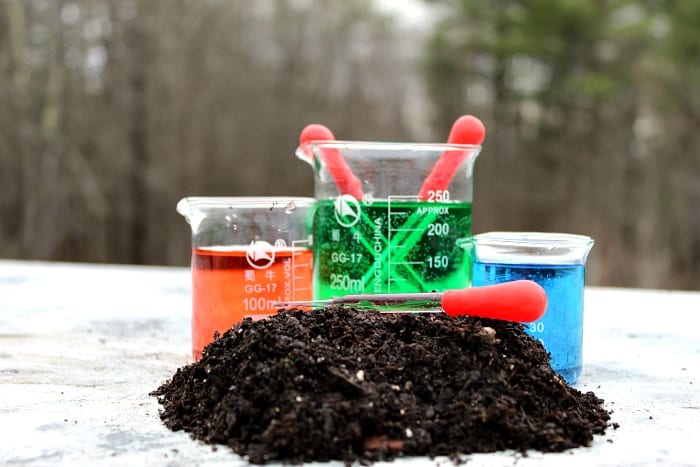Yes, the 3 numbers on your fertilizer bag are important! These numbers represent nutrients NPK and they play important roles in your lawn.
When most people shop for a bag of fertilizer they usually rely on the marketing descriptions printed on the front of the bag rather than reading the small print at the bottom.
The truth is, that boring small print next to the bar code is actually the most important part. This is usually where the ratios of NPK are.
What Do the Numbers on Fertilizer Mean?
When you look at a bag of fertilizer you will most likely see 3 numbers. For example 32-0-4. These numbers are simply a ratio. They represent the percent of Nitrogen, Phosphorus, and Potassium in the bag.
The first number tells you the percent of Nitrogen (N). The middle number tells you the percent of Phosphorous (P), and the last number tells you the percent of Potassium (K).
If you add up the percentages from using are example above, you’ll realize that 32-0-4 only adds to a total of 36%. The remainder of the bag is filler material which is usually sand, sawdust, granular limestone, ground corn hubs, peat moss, or dirt.
NPK Fertilizer Uses
Nitrogen, Phosphorus, and Potassium are the 3 main macro nutrients your lawn needs to be healthy. Each play an important role:
Nitrogen (N)– Nitrogen is the most important nutrient in your lawn. It is most responsible for promoting green, lush blade growth. This green foliage allows the grass to photosynthesize and provide energy and strength to your grass.
Phosphorus (P)– Phosphorous is responsible for promoting root growth. It’s seen in higher percentages in starter fertilizers since it helps aid in seed germination and root development.
Potassium (K)– Potassium helps the internal processes of the plants cells. It helps with photosynthesis, absorption, respiration, and protein production. This helps the lawn adapt to harsh conditions. Potassium helps protect your lawn when it heads into periods of stress such as the heat of the summer or cold winter months. It’s the most important nutrient to apply to your lawn before a period of dormancy.
How to Know Your NPK Levels?
Test your soil! A soil test is the only real way to test for these macro nutrients.
Most do it yourselfers are intimidated by soil tests but the truth is it doesn’t have to be complicated.
A really simple, but accurate soil test is the Yard Mastery Test. This is a kit where you mail in your soil sample and it gets analyzed in a lab. You get a detailed analysis of your soil including the macro nutrients, micro nutrients, and PH.
For more option on soil tests and how to read them check out How to Do a Soil Test (And Read It).
How to Use NPK Ratios In Your Lawn Care Program?
For established, healthy lawns…
Stay balanced by applying NPK at a ratio of 4 : 1 : 2. These ratios are based on the entire season. I’m not saying every application should be in a ratio of 4 : 1 : 2. In fact, sometimes throughout the season I’ll apply mostly nitrogen. Other times I might apply mostly potassium with little nitrogen. It all balances out in the end. And it doesn’t have to be an exact science, just use these numbers as a rough gauge.
Currently, my 3 most used fertilizers throughout the season are Milorganite 6-4-0, Flagship 24-0-6, and Stress Blend 7-0-20. This combination helps me stay balanced.
For Stressed Lawns…
Look for a fertilizer with a higher Potassium level. This will help your lawn resist against disease which is important since stressed lawns are more susceptible to disease.
A product like Stress Blend 7-0-20 is great to apply for times of the year when your lawn is likely to be stressed. It is slow release and contains Potassium. This is my go to fertilizer when I’m heading into stressed lawn season, which for me in the Northeast is summer.
If your lawn is severely stressed than get to the root of the problem before applying any type of fertilizer. Adding fertilizer to a severely stressed lawn can make things worse.
For New Lawns…
You want a high middle number which is Phosphorus. Phosphorus will help your lawn build a healthy root system so it can get established. A starter fertilizer is a good choice since it contains higher Phosphorus levels.
Overall, being aware of your lawns nutritional needs can save you a lot of money. Applying unnecessary nutrients to your lawn is not only a waste of money but it is also has negative impacts on your lawns health.
So next time your in the store picking out your fertilizer, don’t just pick out the bag with the highest 3 numbers. Instead, focus on staying balanced and applying the right fertilizer at the right time to give your lawn the nutrients it needs most during that specific time.
Check Out These Posts Next
Cool Season Lawn Program Using Only 3 Products
Top Dressing Lawn: Benefits and Advice
Lime Your Lawn: A Complete Guide
Leave Grass Clippings on Lawn or Not?
How to Kill Weeds Without Killing Lawn
Follow Me
Join my free email list!



Love your common sense approach to lawncare and easy to follow advise. My lawn is about 6 years old now and I struggle with crabgrass control.
Thanks Greg, glad I can help! I understand the struggles with crabgrass. Definitely takes a lot of patience and persistence.
Have you ever used the UNH soil lab test and if so what are your thoughts?
I have not… I have friends who have and said its very detailed. Nothing wrong with that but can be overwhelming to some. I’m really impressed with the detail yet simplicity of the Yard Mastery Test. Took about a week to get back, Check out the link Yard Mastery
Hello there. Thanks for the great info. I did a soil test and it’s low in Nitrogen. I’m a few days out from my first pre-emergent treatment. Should I still use the Lesco Dimensions 19-0-7? Or, do I need one with a higher nitrogen?
Hi Karen, I definitely encourage you to read this post: How to Fertilize Your Lawn It can be kind of confusing to wrap your head around this concept (it was for me at first)… if you’re applying 3/4lb of nitrogen per 1000 s/f, it doesn’t matter if the first number on the fertilizer label (nitrogen) is high or low. If it’s a high first number it just means that there’s a higher percentage of nitrogen in the bag. Meaning you won’t need to apply as much to get your 3/4’lb of nitrogen per 1000s/f. If it’s a lower number on the bag it simply means you’ll need to apply more of it to get the same amount of nitrogen. Yours is a great question and I think the explanation makes pretty good sense in the How to Fertilize Your Lawn Post. Let me know if you have any more questions!